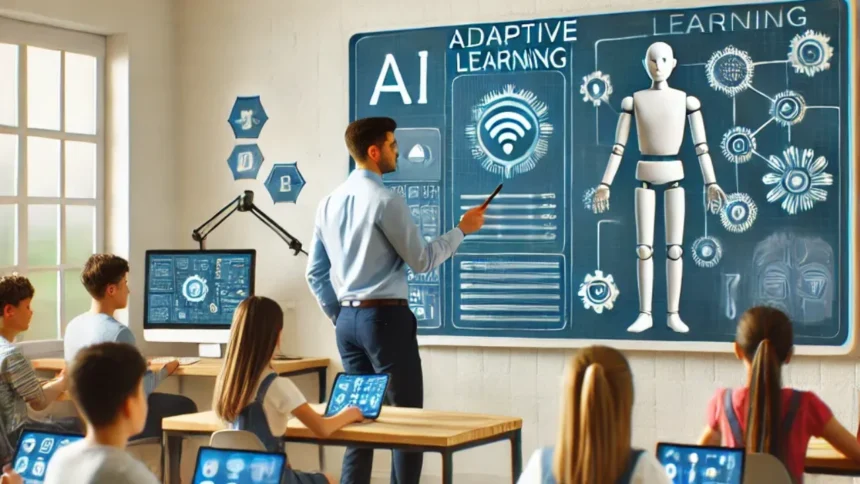Artificial intelligence is transforming education, from personalised learning tools to instant feedback systems. However, as more schools introduce these technologies, educators must understand how to use AI safely in the classroom. The goal isn’t just to embrace innovation but to ensure that it benefits students ethically, responsibly, and securely.
AI can enhance learning outcomes and reduce teachers’ administrative workload, yet it also presents risks: data privacy breaches, over-reliance on automated systems, and potential bias in algorithmic outputs.
This guide provides practical strategies, ethical frameworks, and real-world tips to help teachers use AI confidently and safely in the modern classroom.
Understanding AI in Education
Artificial intelligence refers to systems capable of analysing data, making predictions, and performing tasks that usually require human intelligence. In the classroom, AI is being used to create personalised learning paths, automate grading, offer instant feedback, and assist students with learning difficulties.
While AI can support and augment teaching, it should never replace the human element. Teachers remain the guiding force, interpreting AI-generated insights, and ensuring that technology aligns with curriculum goals and learning outcomes.
Why Safe AI Use Matters
AI offers many benefits but also introduces potential risks. Students might misuse AI for plagiarism, share sensitive data inadvertently, or rely too heavily on automated solutions. Key areas of concern include data privacy, algorithmic bias, academic integrity, and over-reliance on technology.
To mitigate these risks, teachers must implement safe practices, protect student information, and foster an environment where AI is a tool for learning rather than a shortcut to completing assignments.
Best Practices for Using AI Safely in the Classroom
Implementing AI in education should follow clear safety, ethical, and pedagogical guidelines. Here are practical steps teachers can take:
1. Evaluate AI Tools Carefully
Before introducing any AI application, research its purpose, data policy, and credibility. Ask:
- Who developed it, and what data does it collect?
- Does it comply with local or international data protection laws?
- Is the content appropriate for your students’ age and level?
Only use tools with transparent privacy statements and secure data handling processes.
2. Obtain Consent and Communicate Clearly
Inform students and parents about how AI tools are used in the classroom. Seek parental consent for tools that process personal information. Transparency builds trust.
3. Combine Human Oversight with AI Support
AI can provide recommendations, but teachers should make final decisions on grading, feedback, or student assessment. Technology should augment, not replace, human judgement.
4. Establish Classroom Policies
Create a classroom “AI Code of Conduct” outlining acceptable use:
- When and how students may use AI tools.
- Consequences of misuse or plagiarism.
- Clear examples of ethical vs. unethical use.
This helps set boundaries and encourages responsible behaviour.
5. Protect Student Data
Never use AI platforms that require unnecessary personal data or share information with third parties. Use school-approved, encrypted tools where possible.
Teaching Students to Use AI Responsibly
Educators must go beyond teaching with AI to teaching about AI. Students need digital literacy skills that empower them to question, verify, and use technology ethically.
Encourage students to:
- Understand how AI generates outputs and recognise potential errors or bias.
- Use AI for idea generation, not for replacing their own work.
- Credit AI assistance transparently when used in assignments.
- Think critically about information provided by AI tools.
Teaching responsible AI use prepares students for a future where digital ethics are as vital as academic knowledge.
Recommended AI Tools for the Classroom
While avoiding tables, it is still useful to highlight some commonly used AI tools with safety features:
- Khanmigo (Khan Academy) supports personalised tutoring and explanations while complying with data protection regulations.
- Grammarly for Education provides writing feedback with transparent data controls.
- Google’s Read Along helps with reading comprehension, using offline modes and minimal data storage.
- Turnitin with AI Detection supports academic integrity with secure data handling.
- Socrative allows formative assessments and quizzes in a secure, privacy-conscious manner.
Teachers should always review privacy policies and evaluate how each tool aligns with classroom objectives before implementation.
Aligning AI Use with School Policy and Law
Responsible AI adoption must align with both educational policies and data protection frameworks. Teachers should:
- Consult school ICT policies and ensure any AI tool used has administrative approval.
- Follow GDPR, COPPA, or local equivalents when processing student data.
- Maintain digital records of consent and tool evaluations.
- Engage with administrators to update safeguarding and ethics policies as AI evolves.
Schools can also partner with tech providers to ensure compliance and request custom features like restricted data access or anonymisation.
FAQs About How to Use AI Safely in the Classroom
What is the safest way to introduce AI tools to students?
The safest approach is to start with school-approved, privacy-compliant tools, explain their purpose clearly, and obtain parental consent where needed. Teachers should combine AI use with guidance and oversight to prevent misuse.
How can teachers ensure students use AI ethically?
Teachers can create clear classroom policies, educate students on responsible use, and emphasise critical thinking. Encourage students to credit AI when used and to question AI outputs rather than accepting them blindly.
What privacy concerns should educators be aware of?
AI platforms often collect data such as student names, grades, or behavioural patterns. Teachers should choose tools with strong privacy policies, avoid unnecessary data collection, and comply with regulations like GDPR or local data protection laws.
Can AI replace teachers in the classroom?
No. AI is designed to assist and enhance teaching, not replace human educators. Teachers remain essential for interpreting AI insights, providing feedback, and guiding students’ ethical and intellectual development.
How can AI support students with learning difficulties safely?
AI-powered tools can personalise learning, offer extra practice, or provide assistive features such as speech-to-text. Safe use involves monitoring outputs, protecting data, and ensuring the technology complements individual learning plans.
__________________
Bookmark Techparley.com for the most insightful technology news from the African continent.
Follow us on Twitter @Techparleynews, on Facebook at Techparley Africa, on LinkedIn at Techparley Africa, or on Instagram at Techparleynews.






